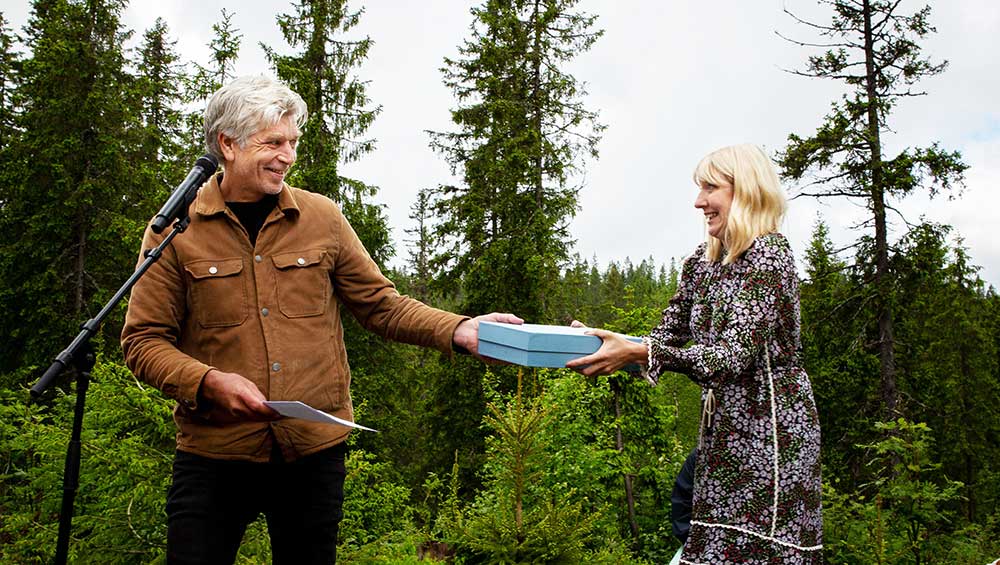
Future Library. Karl Ove Knausgård hands his manuscript to Katie Paterson, Nordmarka forest, Oslo, Norway. Photo: Kristin von Hirsch.
by VERONICA SIMPSON
Future Library is a most extraordinary artwork, involving the planting of 1,000 trees in 2014, which will be used in a century’s time to supply paper on which to print 100 manuscripts. Over the 100 years, one writer each year will contribute a work: the texts will lie, unread, in locked drawers in a silent sanctuary, until they are finally published until 2114.
The writers who have agreed to contribute a book for which they will never receive any feedback or praise are also remarkable: Margaret Atwood was the first, in 2014, David Mitchell was second, followed by an international selection of equally outstanding writers who have lit our collective imaginations with their various meditations on everything from time-travel, through our relationship with this fragile planet, to what it is to be human.
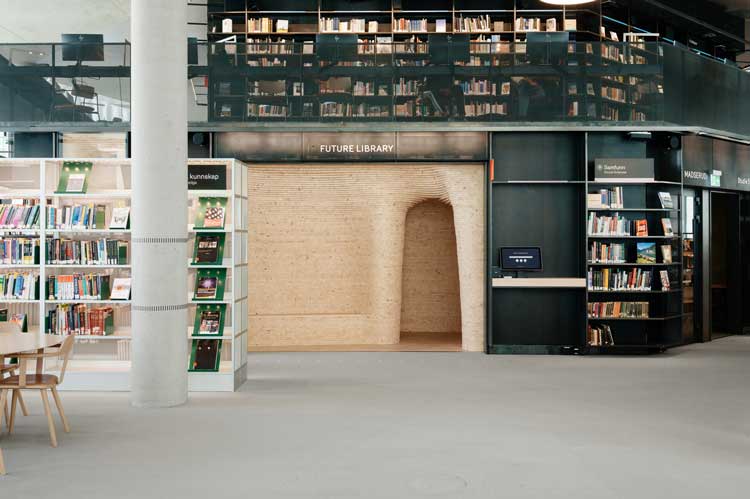
The Silent Room, in the new Deichman Bjørvika library. Photo: Einar Aslaksen.
For the Scottish artist Katie Paterson (b1981, Glasgow), it was one of many ideas – some impossible, some just about possible – that she has been nurturing and noting down over two decades of artistic practice, since she was a student. She has it still in her notebook of ideas (published in 2019 as A Place that exists Only in Moonlight), written down as: “A forest of unread books growing for a century.” She probably thought this was one of the “impossibles”, until she was invited to Oslo in 2010 by the cultural producer and public art curator Anne Beate Hovind, as part of UK public art agency Situations’ Slow Space programming for Bjørvika, the former industrial docklands area of Oslo that is fast becoming Oslo’s new cultural quarter, with an opera house, a new library and the Munch Museum.
In the way of all genius ideas and their successful fruition, it was a case of right place, right time and, above all, right collaborators: Paterson intuited that the nature-loving, tree-husbanding, literary and culturally supportive atmosphere of Norway might well provide fertile soil to help this idea grow. With the enthusiasm of Hovind, the seed was planted, and Paterson acknowledges it would never have grown if not for Hovind’s energy, passion and commitment, and her cultural and political networks – which included enthusing the director of Bjørvika’s as yet unbuilt library (of which, more later).
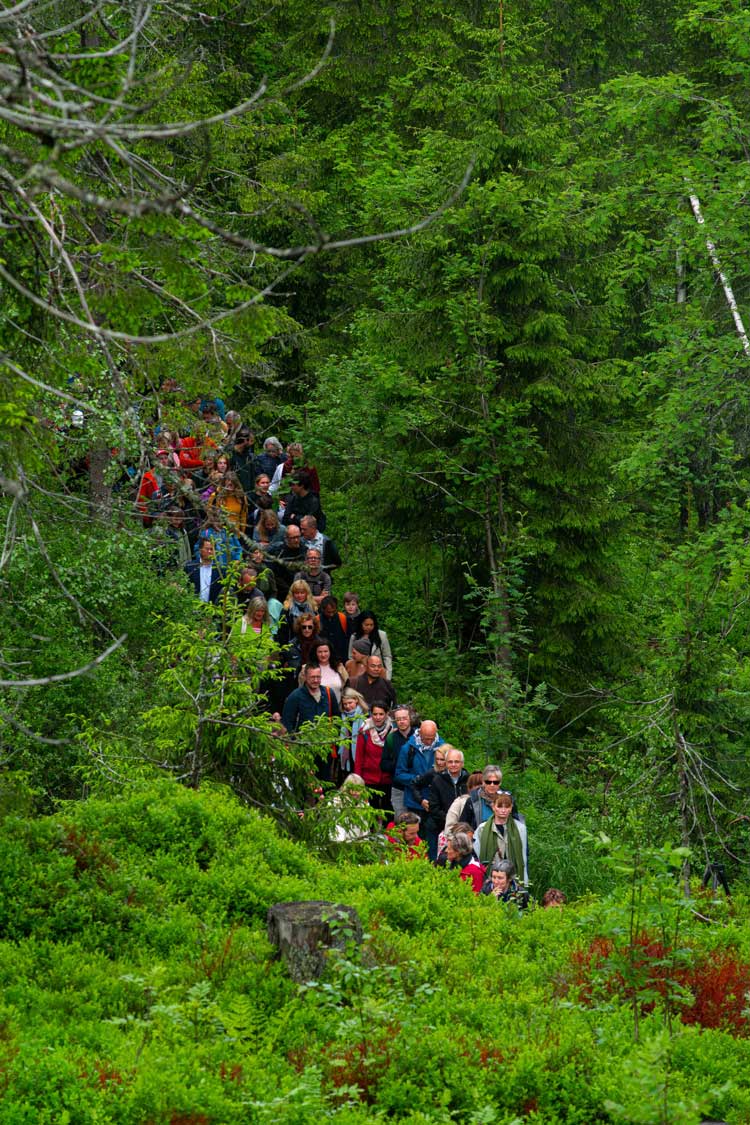
Future Library 2022, Walk, Nordmarka forest, Oslo. Photo: Jola Josie.
In June, eight years since Atwood took the inaugural stroll through the Nordmarka forest, just outside Oslo, to the clearing where Paterson’s trees have been planted, to hand over her unread manuscript for safekeeping (this annual ritual is an important part of the project), the Future Library reached a major landmark in its evolution: the Silent Room, in the new Deichman Bjørvika library, was unlocked and the first seven manuscripts laid inside it. Also, and most importantly, this summer, the City of Oslo signed a legal document guaranteeing that it will take care of and support this project for the whole of its century-long gestation.
Paterson’s art explores time and space: weaving together past, present, future, she articulates our relationship to the planet, its geologies and the wider galactic history. She usually brings in rich sources of data (and materials) in collaboration with geologists, astrophysicists, botanists and archaeologists, and transforms them into conceptually rich and visually arresting works. But the Future Library takes her art into new realms, including land art (trees repurposed, planted and ultimately harvested, walking rituals generated and repeated through annual pilgrimages), architecture/sculpture (the Silent Room is a very tactile, sculptural, haptic space) and, of course, literary art. That brings in another vital element: participation, most importantly that of the invited writers, without whom this work would not have a fraction of the currency or fascination.
It must have been hard to know how authors of the calibre that they wanted to recruit would respond. But having secured the participation of Atwood, Mitchell was happy to comply. Subsequent authors were: Icelandic poet and novelist Sjón (2016), Elif Shafak (2017), Han Kang (2018), Norway’s own Karl Ove Knausgård (2019), Ocean Vuong (2020) and Tsitsi Dangarembga (2021). The writer for 2022 will be announced imminently. After the hiatus of the last two years, this year’s Future Library ritual drew a far bigger crowd than usual. Anyone can participate in the procession through the woods with authors and new manuscripts. On a breezy June morning, more than 200 people gathered on the edge of the Nordmarka forest, which is filled with Norwegian spruce, birch and pine. We walked for half an hour – sustained by free coffee and cinnamon buns – to the clearing made in 2014 (as part of the usual forestry maintenance and harvesting cycle) where Paterson’s 1,000 trees had been planted. We had previous writers Mitchell and Sjón in attendance, as well as two of the three latest authors, Knausgård and Dangarembga, who had not yet had a chance to hand over their manuscripts in the woods, thanks to the pandemic; Vuong had contracted Covid at the time of the ceremony so could not join us.
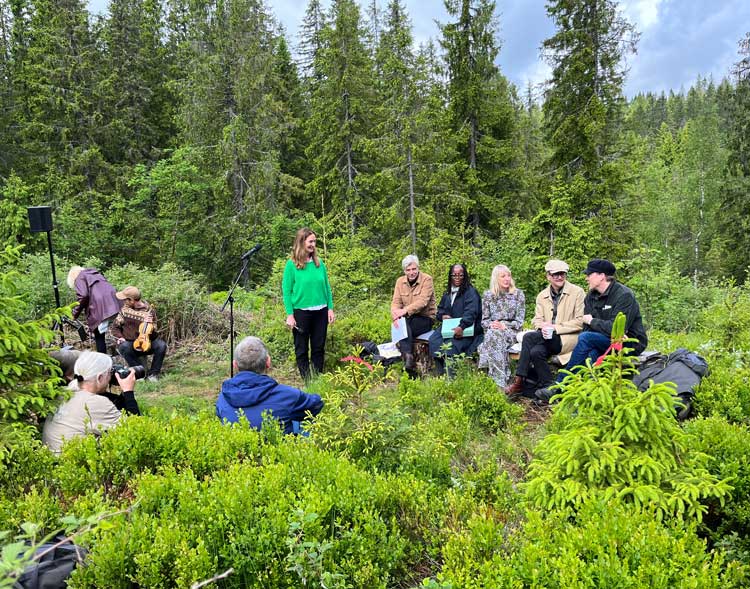
Future Library 2022. Speeches in the forest, Left to right: public art curator Anne Beate Hovind, Karl Ove Knausgård, Tsitsi Dangarembga, Katie Paterson, Sjón and David Mitchell. Photo: Veronica Simpson.
There was singing, there were readings and speeches, and there was an emotional moment for all when the crucial legal document that guarantees Oslo’s stewardship of the project for the next 100 years was handed over. The event – as it is each year - was livestreamed all over the world to Future Library followers. Later that afternoon, there was an even more emotional moment at the Deichman Bjørvika library, when the ribbon across the Silent Room was cut by Oslo’s mayor, Marianne Borgen, and all the authors present were invited to deposit their manuscripts into the slim metal trays, fronted by hand-blown glass panels, in the newly opened Silent Room, knowing that they would remain untouched and unread until long after the writers are dead.
Paterson’s profile in Norway has undoubtedly been boosted by the strange and wonderful work she has conjured. But the Norwegians can now understand it in the context of her wider practice, thanks to her first solo show in Norway, Evergreen, which opened at the end of May. In a handsome 19th-century farmhouse that is now the home of Galleri F15, in Moss, an hour’s train journey north of Oslo, two floors have been filled with her works. For those of us familiar with Paterson’s poetic, cosmic evocations, the tranquil, forest-fringed setting on the edge of the ocean conjures that bit more meditative magic.
-by-Katie-Paterson-Pic-V-Simpson-.jpg)
Katie Paterson, Evergreen, 2022. Embroidered linen. Installation view, Galleri F15, Moss, Norway. Photo: Veronica Simpson.
There are new works, some of which are companion pieces to the excellent exhibition, Requiem, on recently at Edinburgh’s Ingleby gallery. There is, for example, another of her embroidered linen works, Evergreen (2022), after which the show is titled, featuring more than 300 extinct flowers, drawn by the botanical artist Deborah Lambkin and stitched by scholars at the Royal School of Needlework. There is a companion piece also to her new work Endling (2021), as seen at Ingleby, which features a circle, 1 metre in diameter, divided into 100 sections, each of which has been painted with pigment made from crushed and dissolved fossilised remnants, to tell the story of our planet’s evolution in slices of ochre, grey, russet and gold, some of which seem speckled with stardust.
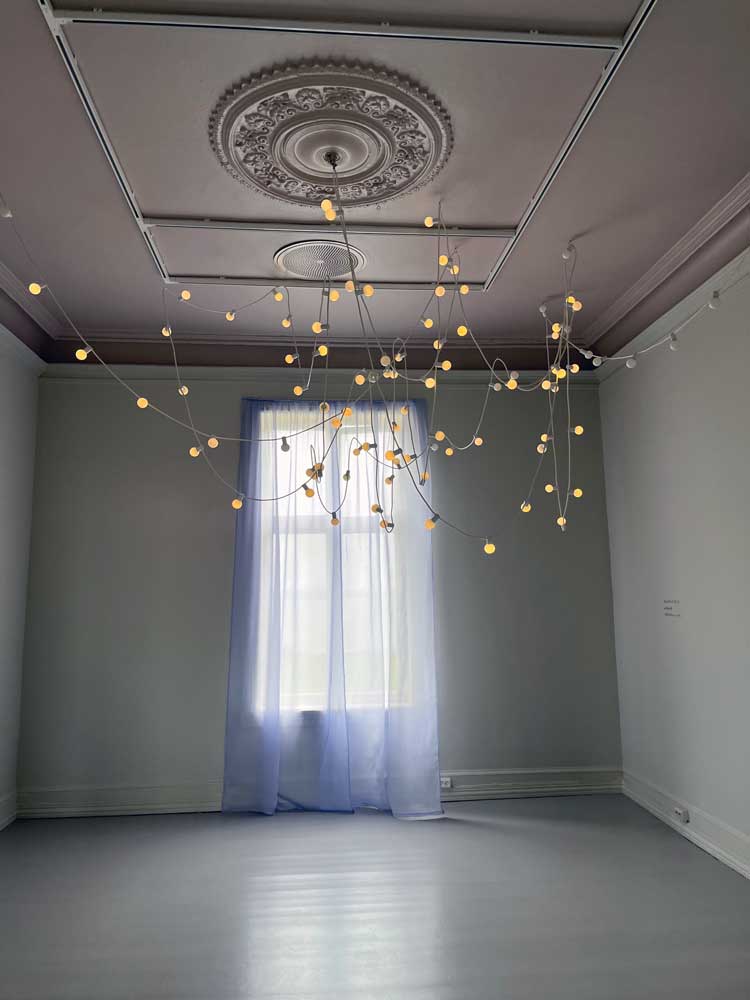
Katie Paterson. Festoon lights as Ara constellation, with silk curtains beyond, dyed the colour of the first stars. Installation view, Galleri F15, Moss, Norway. Photo: Veronica Simpson.
But I loved the interplay between these and her earlier works, such as her festoon lights carefully calibrated to reflect the luminosity of specific constellations. Both Ara and Phoenix are draped across the ceilings of two pale, grey-tinted rooms on the first floor, accompanied by a new work, comprising silk curtains dyed the colour of the first stars. As these blue-hued, gossamer-light fabrics billowed gently in the summer breeze, they were accompanied by the soundtrack from her Earth-Moon-Earth (2008) work, comprising Beethoven’s Moonlight Sonata, which she broke down into morse code and bounced off the moon, then played back in its recognisable but occasionally fractured form, with gaps appearing where the code has been “lost” in the moon’s craters.
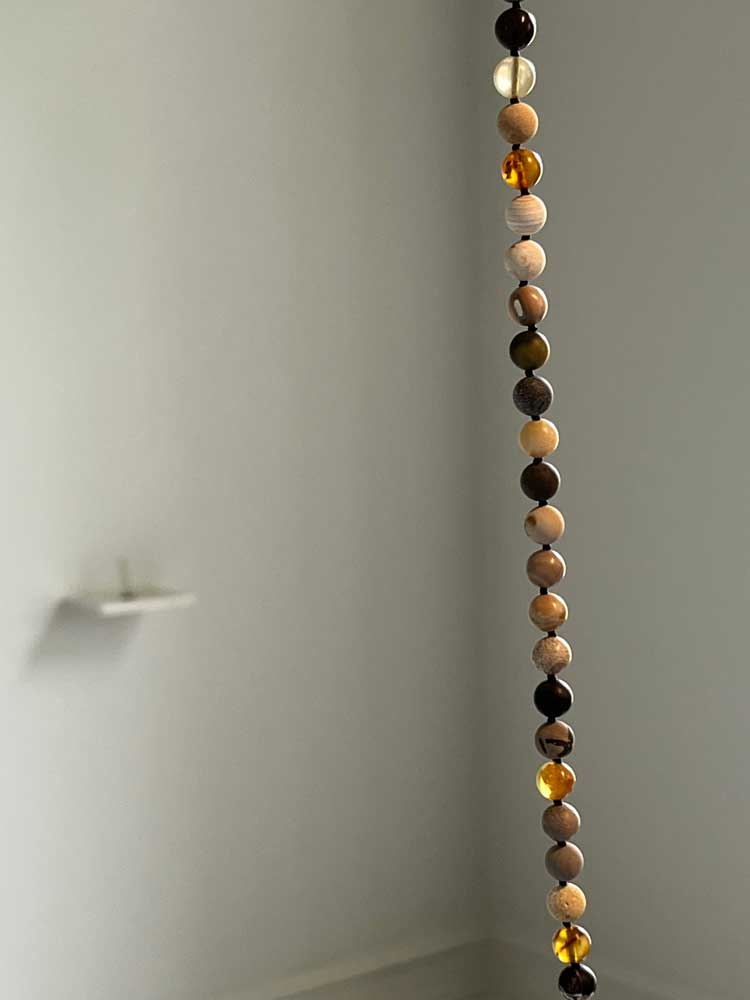
Katie Paterson. Fossil Necklace, 2013. Installation view, Galleri F15, Moss, Norway. Photo: Veronica Simpson.
Another favourite older work, Fossil Necklace (2013) – made from 170 carved, rounded fossils arranged in chronological order according to the history of the Earth, strung on silk – hangs in the centre of a room accompanied by the scent of the first forest, emanating from one of her To Burn, Forest, Fire (2021) incense sticks, made to evoke the scent of the first forests on Earth, from 385m years ago.
The show will continue until October. But the Future Library is good for another 92 years - until 2114, as evidenced by the newly opened Silent Room, which Paterson devised with the library’s architects, Atelier Oslo and Lundhagem Architects. It has the feel of a cave but with none of the coldness. Instead, there is a warmth and fragrant sensuality thanks to its timber contours; in fact, it is more like a womb than a cave. It has been constructed from 16,000 wooden blocks, stacked in 100 layers, like growth rings. These blocks come from the original trees that were felled when the Future Library clearing was created. Peppered around its curves are 100 slices of glowing, backlit glass. Behind each glass slit are steel boxes into which each manuscript will be locked. For those that have already been allocated, the year and the name of the author is visible in tiny, frosted letters on the front.
Studio spoke with Paterson in Oslo, on the day after the handover of the latest manuscripts and the opening of the Silent Room.
Veronica Simpson: There is something very magical about being present at the fruition of a project, which I remember being really taken with, in 2016, when I first interviewed you. At that point, you had the forest and two manuscripts, but the room was still an unrealised wish. At what point were you thinking, there has to be a room and how did that vision evolve?
Katie Paterson: It was really early on. It was quite extraordinary how it happened. But the first thing was the forest. That really was where the tree rings gave me this idea: I’d visualised the tree rings as chapters, made that connection between paper and books and trees becoming libraries and libraries being trees in a former life. Having been to Norway, and then returned home, I called Anne Beate and said: “Can I go into the forest? I’ve got this idea, but I need to go there to feel the trees and have the sense of a Norwegian forest.” It was kind of all there in a little vision, but a lot more had to be seen and thought through and I wasn’t ready to do that until I’d been in the forest. So, I went to the forest for more than a week. I had no electricity, no running water. It was incredible. I went walking in the forest every day. Looking at the different tree types is when it became more about different authors … The room was right in the early stages. We met with Liv Saeteren, the previous director of this library, who is on the Future Library Trust board. And it was uncanny … Liv had actually had a vision herself - because they knew they were building a new library - of a room in it to hold unpublished texts. As time went on, it had disappeared from the plan, but they’d always kept a space in the architectural plans for this sort of beginning of an idea … but it wasn’t a priority. Then I came along and told her about the trees and the idea of growing this collection of unread books. And then I said: “We need to put the manuscripts somewhere, and could it be part of the library?” It was this extraordinary moment of serendipity. There was this little footprint in the floorplan ready for us to appear. Which is quite magical, I think. That’s how the room came about.
As to the actual design and building of the room, we cut the trees in the forest, in 2014, as part of the natural regeneration of the forest. We stored the wood since then, which has been dried and taken care of. And I worked with the architects of the library, Lundhagem and Atelier Oslo to design this room that’s going to hold the manuscripts. I always knew it would be made from the wood that we’d cleared from the forest - I thought these trees have to be part of this project, because we’re moving in on the forest space.
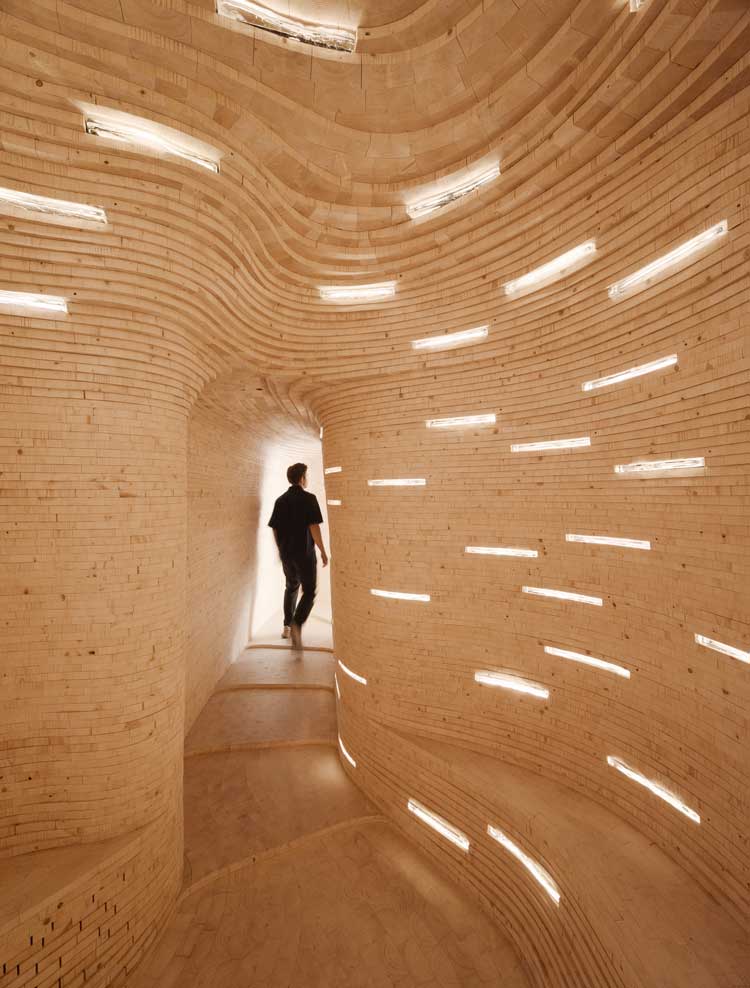
The Silent Room interior, in the new Deichman Bjørvika library. Photo: Einar Aslaksen.
We always knew it was going to be very small. It’s 12 sq metres. We went through various design phases, but we looked very specifically at quite sacred spaces, temples and contemporary temples and spaces of meditation, in nature, and lots of spaces made with wood. We wanted a very stripped back, minimal aesthetic. We’re using as few materials as possible because we knew this has to last 100 years. We were stripping away everything unnecessary. We wanted it to be cosy and embracing. We did not want the feeling of claustrophobia, so we introduced the idea of daylight coming in through the (top) window.
For the entrance, we wanted to be able to take people on a little journey. This is tricky with only 12 sq metres. We wanted people to be able to enter the room and not see the manuscripts until you are a little way in. So, you enter a tiny passageway and then the manuscripts appear around you. You see 100 drawers, which contain the author’s manuscripts. Their names are inscribed, frosted on to this handmade cast glass, and inside there are drawers. It’s so story like. And the drawers come out and we put the authors’ manuscripts in and they click into place and are locked. There are many handmade keys for these different drawers, which are going to be stored in a safe with Norway’s oldest book in the library. We’re crossing all these time zones.
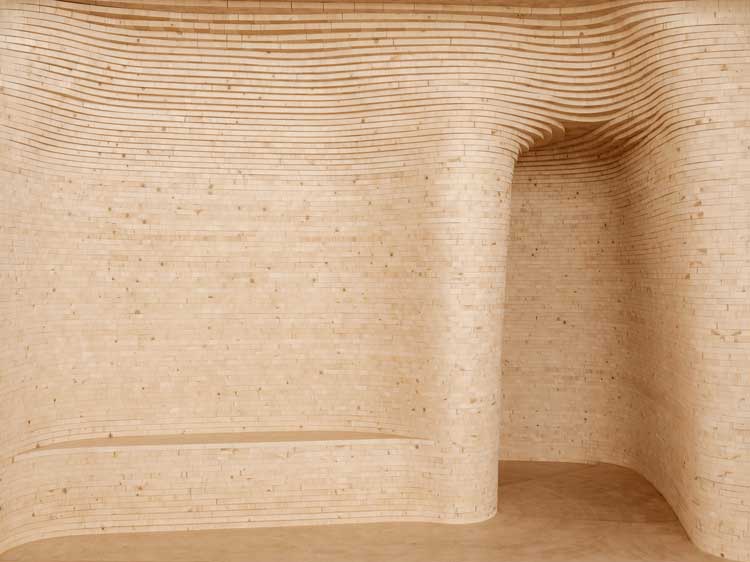
Deichman Bjørvika library, silent room entrance. Photo: Einar Aslaksen.
But when people visit, there’s just you in there, and your imagination, really allowing you to travel to the forest, and inside these manuscripts, wondering what’s hiding in there. At the talk before the room was opened, David Mitchell was talking about a Wunderkammer, this being a cabinet of wonders. And, kind of by accident, the room is facing in the direction of the forest. I think eventually we might put a telescope that physically connects you to the trees. We finished it two years ago, but, thanks to Covid, yesterday was the first day I went inside. It was so amazing to see the authors put their manuscripts in. They were really moved and so were we, by this important part of the ritual.
Perhaps another of the inspirations behind it is that, when I was in Japan (for the Yokohama Triennale, 2017), I went to a shrine called Ise Jingu (a Shinto temple). They rebuild the temple there every 20 years, using new wood but in exactly the same form. They have been doing this for 2,000 years. It’s extraordinary. It’s this contemporary place that is so imbued with the past you can’t separate them at all. The trees they use come from a sacred mountain where they are grown specifically for the temples. That crept in for me when we designed the room: the trees, which have, for me, some kind of sacredness, become this room that will span time, and outlive us all. Even the lighting has to be designed in the way that everything has to be designed – with longevity and care. By stripping the materials back to just wood, just glass, just light, and using building techniques that avoid nails or glue, we’ve tried to make something that is the essence of itself.
VS: Do you have special memories of being a child in the forest?
KP: Ah, no, but when someone at the talk yesterday mentioned Narnia, [CS Lewis’s] The Lion, the Witch and the Wardrobe was such a big book in my childhood. And that entering the wardrobe aspect, I think it’s what I still do.
VS: So much of this has been brought into being by other people, so participation was incredibly important. What was it like to have such a collective aspect to the work’s evolution?
KP: I feel like, today, I’m on some dreamy cloud. Yesterday, it’s almost not sunk in what happened, but because we’ve been distanced for a couple of years, because we have a couple of authors with us instead of one, and we came together physically for the first time in years, it’s been amazing. So many people came, and they were queuing in the forest, to come to this very humble ceremony. One of the things I came away with yesterday was how the whole thing felt humbling: so many people there from all walks of life, the librarians, the architects, the foresters, the journalists, and there was a bit of a hush. And we all forgot what we did. It was just being very present. And it wasn’t a really long ceremony, but there was this idea of stepping outside - or inside – time into the present moment. I think we shared that together in a really strong way. Every ceremony brings something new and very different. Han Kang dragged a white cloth through the forest on the way to the clearing, and she wrapped her manuscript in it, and we did it in silence so that was a totally different atmosphere and feeling. But somehow this one, I just felt so emotional through the whole thing. And especially with that contract – the 100-year contract. Of all the things, the music, the beautiful words, it was the contract that got me crying. And that’s because it’s huge: basically, it’s the city giving us a huge stamp of approval and saying we’re going to do this. And though we’ve always had that faith, to have the city finally commit. Well, they’ve never done a 100-year contract before. It’s taken years. There isn’t anything comparable. So that contract getting signed and handed over to us, it’s more than the project. It’s like you believe in the future, and I believe you and I believe you want to not only bring this book into fruition, but you are looking at our future ancestors and giving them a place. And it was this communal feeling of we’re all in this together.
VS: Do you have a list of authors lined up for the near future?
KP: What we do, as a Trust, we’re choosing authors this year. We’re not stacking up a list of people, which would be very easy for us, if we asked authors in advance and planned ahead. Because something shifts every time and you’re in a completely different space again. So, the project always has to respond to this present, in order to bring it into the future and mark whatever the year is. We haven’t invited the next author. It’s a bit of a risk, especially for authors who write on really long cycles. They have a year from when we invite them. Then they have to bring it to the woods.
VS: There was a particularly lovely moment with the minute’s silence (after a Buddhist blessing, requested by the absent Vuong). We listened to the trees, the birds, and I remembered a wonderful notion I heard last year, that language may have evolved because we heard birds communicating with each other, and we thought we’d like to do that.
KP: It’s true, in that moment of silence, especially after the Buddhist blessing, bringing you into this … mantra-like state, then you have the moment of calm, and the forest responds. You open your ears and it’s so alive.
VS: It is a unique project in terms of spanning the divide between visual art and literature. It is an extraordinary combination of the two. There is nothing else like it in either field.
KP: I think that’s it. I think that’s why it brings people in. It’s literature, it’s architecture, it’s books, it’s nature, within all of us. It’s a real mixing of fields.
There’s no way this could have happened individually, it’s totally collective. And I love that, and it gives me hope and belief that somebody took that on and didn’t take the easy path – they took it on because they thought we’ll do something different, take a risk, expand the idea of what an artwork can be. It’s a living project, changing and surprising us and we take it as it comes, knowing that, as the forester so beautifully said yesterday: “The root systems are established.” And that’s what I really felt yesterday and today: the root systems overall, metaphorical and actual, they’ve taken shape and it makes me feel very relieved and proud.
• Katie Paterson: Evergreen is at Galleri F15, Moss, Norway, until 5 October 2022.